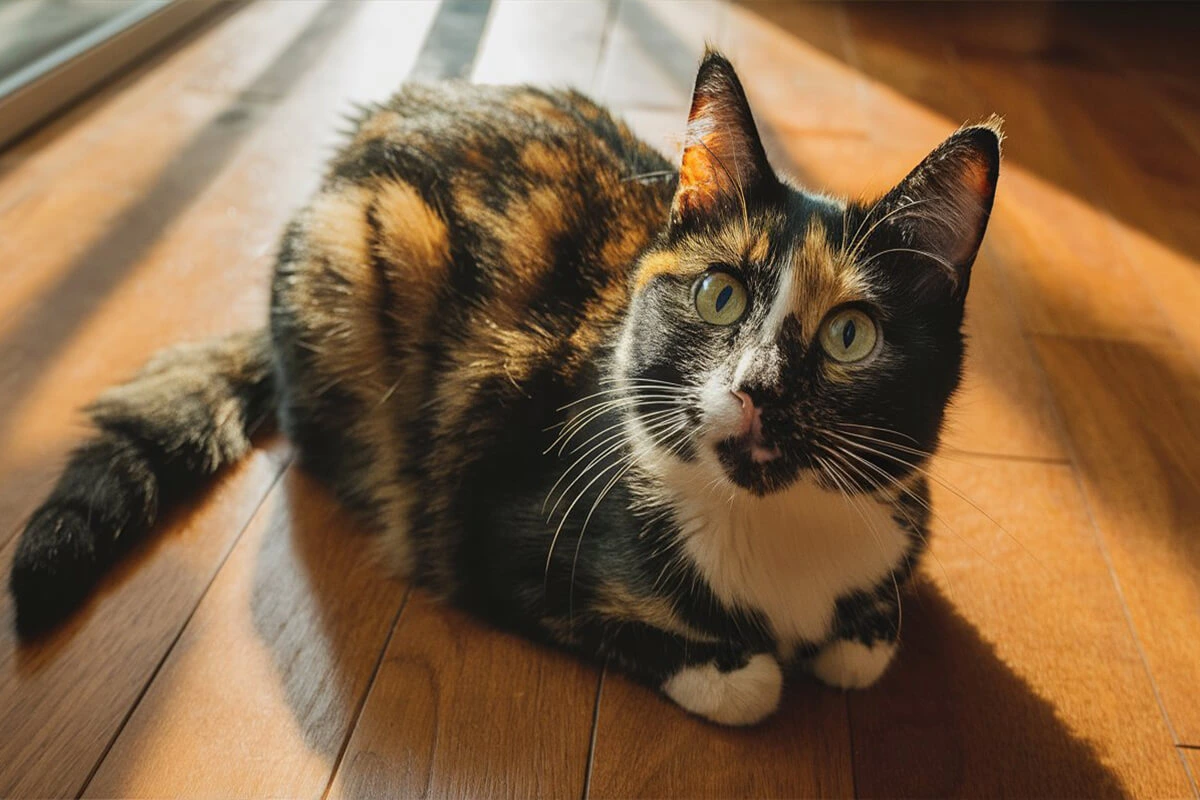The Tortoiseshell cat stands out with His striking multicolored coat and strong-willed personality. Cat lovers admire them for their unique appearance and feisty temperament, often described as “tortitude.” These cats bring joy, mischief, and affection into their owners’ lives, but caring for them requires attention to their specific needs.
Torties don’t belong to a single breed; instead, their distinctive coat pattern appears in different breeds. Their independent nature, playful energy, and occasional stubbornness make them fascinating companions. Understanding their personality, diet, grooming needs, and health concerns ensures they live a happy and fulfilling life.
In this guide, you’ll discover ten essential care tips to keep your tortoiseshell cat healthy, comfortable, and thriving. From feeding and grooming to training and veterinary care, each section will help you provide the best possible environment for your beloved tortie.
Understanding Your Tortoiseshell Cat’s Unique Personality
Tortoiseshell Cat Personality
Tortoiseshell cats have a reputation for their strong-willed and spirited nature. Many cat owners use the term “tortitude” to describe their feisty and independent attitude. Unlike some cat breeds known for their calm and laid-back demeanor, torties often display boldness, curiosity, and an opinionated streak. They love attention on their own terms and may switch from affectionate purring to playful swipes in seconds.
These cats form deep bonds with their owners but often show favoritism toward one person in the household. Some torties follow their favorite human around, demanding attention with persistent meows, headbutts, or even playful nips. They also express emotions vividly, whether they feel happy, annoyed, or excited. If you adopt a tortoiseshell cat, expect a companion with a big personality, a mischievous streak, and a love for adventure.
Feline Behavioral Traits
Tortoiseshell cats exhibit a wide range of behaviors, making each one unique. Some love cuddling, while others prefer to observe from a distance. Their unpredictable nature keeps owners entertained, as they can go from playful zoomies to relaxed naps in the blink of an eye.
Many torties enjoy interactive play, chasing toys, or climbing cat trees. Puzzle feeders and engaging activities keep their sharp minds stimulated and prevent boredom. These cats also tend to be vocal, using a mix of chirps, trills, and loud meows to communicate their needs. Their expressive body language—including flicking tails, slow blinks, and ear movements—helps owners understand their mood.
Some tortoiseshell cats develop strong territorial instincts and may act possessive over their favorite spots, toys, or even people. Training and socialization from an early age help manage any aggressive or dominant behaviors, ensuring a well-balanced and affectionate feline companion.
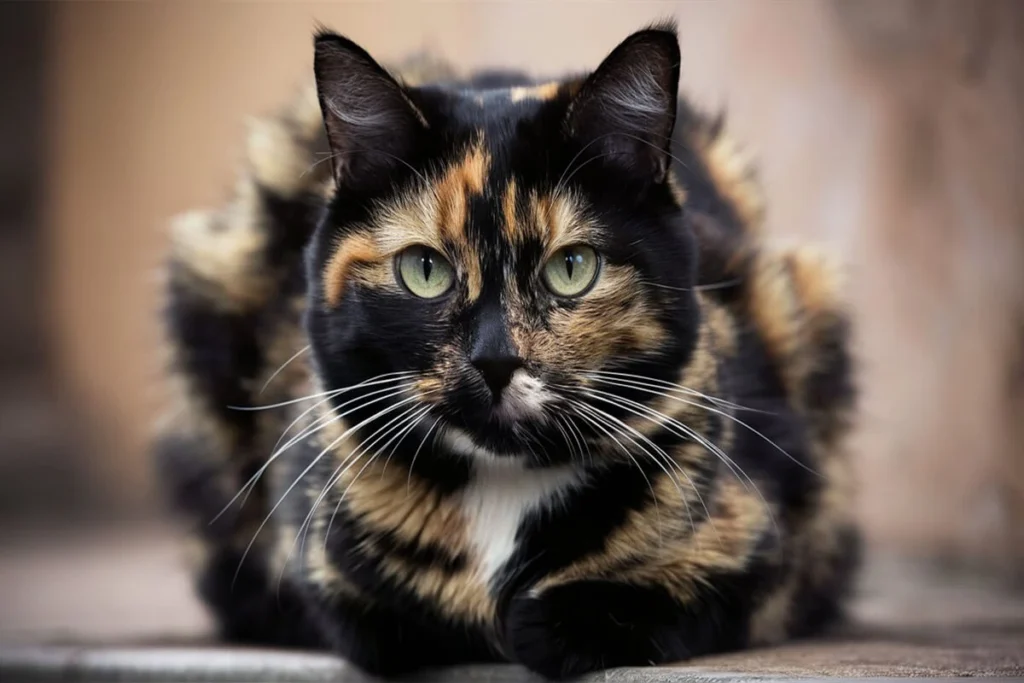
Tortoiseshell Cat Breed Characteristics
Tortoiseshell cats do not belong to a specific breed but rather a color pattern found in various breeds, including American Shorthairs, British Shorthairs, Maine Coons, and Persians. Their distinct coats feature a mix of black, orange, brown, and cream patches, with each cat having a one-of-a-kind pattern. Some torties have striking brindle-like markings, while others have more defined patches of color.
Most tortoiseshell cats are female due to genetics. The orange and black coloration comes from two X chromosomes, which makes male torties extremely rare. When a male tortie is born, he usually has an extra X chromosome (XXY), a condition called Klinefelter syndrome, which often leads to sterility and other health issues.
Since torties appear in multiple breeds, their physical traits and personalities vary. Long-haired tortoiseshell cats require more grooming, while short-haired torties have a lower-maintenance coat. Their size, build, and temperament depend on their breed, but their signature “tortitude” remains a common trait across the board.
Understanding a tortoiseshell cat’s personality and behavior helps owners build a stronger bond and provide the best possible care. Whether they act affectionate, playful, or sassy, these cats bring a unique charm that makes them unforgettable companions.
Providing Proper Nutrition for Your Tortoiseshell Cat
Diet and Nutrition for Cats
A well-balanced diet keeps a tortoiseshell cat healthy, energetic, and free from common health problems. Every cat, regardless of coat color, needs a mix of proteins, fats, vitamins, and minerals in their meals. Since cats are obligate carnivores, they thrive on a high-protein diet primarily from animal sources. Lean meats like chicken, turkey, and fish provide essential amino acids such as taurine, which supports heart and eye health.
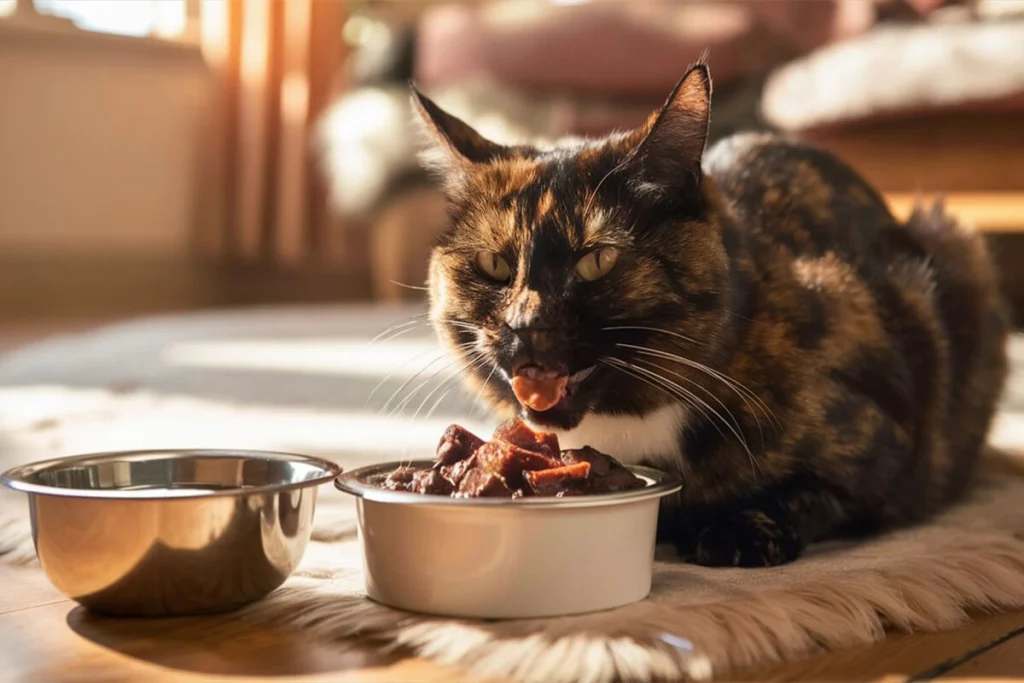
High-quality commercial cat food, whether wet or dry, contains the right blend of nutrients, but owners should always check ingredient labels. Avoid cat food filled with artificial additives, excessive carbohydrates, and low-quality protein sources. Wet food keeps cats hydrated and supports kidney health, while dry food helps with dental hygiene. A combination of both can offer balanced nutrition.
Fresh water should always be available to prevent dehydration, especially for cats that eat mostly dry food. Many cats prefer running water, so a cat water fountain can encourage better hydration. Treats should make up no more than 10% of a cat’s daily calorie intake to prevent weight gain and nutritional imbalances.
Feeding a Tortoiseshell Cat
Tortoiseshell cats may develop unique eating habits based on their personality. Some act like picky eaters, while others beg for extra treats or sneak food from counters. Establishing a consistent feeding schedule helps regulate their appetite and prevents overeating. Most adult cats thrive on two meals a day, while kittens need smaller, more frequent meals.
Portion control plays a crucial role in keeping a tortie at a healthy weight. Overfeeding leads to obesity, which increases the risk of diabetes, joint issues, and heart disease. Using a measured scoop or an automatic feeder prevents overfeeding and ensures consistency. If a tortie refuses food or suddenly eats less, a vet visit may be necessary to rule out health issues.
Some tortoiseshell cats develop sensitivities to certain ingredients, leading to digestive problems, skin irritations, or allergies. If a tortie experiences frequent vomiting, diarrhea, or itching, switching to a limited-ingredient diet or grain-free food may help. Always introduce new foods gradually to avoid stomach upset.
Common Health Issues in Cats
Tortoiseshell cats face the same health risks as other felines, but genetics, diet, and lifestyle influence their overall well-being. Obesity remains a top concern, especially for indoor cats that lack regular exercise. A high-protein, portion-controlled diet combined with daily playtime helps maintain a healthy weight.
Urinary tract infections (UTIs) and kidney disease often affect cats, especially if they don’t drink enough water. Feeding a moisture-rich diet with wet food and providing fresh water sources reduces the risk of urinary problems. Signs of a UTI include frequent urination, blood in the urine, or straining in the litter box. A vet should evaluate these symptoms immediately.
Dental disease also affects many cats, leading to painful infections and tooth loss. Regular brushing, dental treats, and professional cleanings keep a cat’s mouth healthy. Bad breath, drooling, or difficulty eating may indicate dental issues that need treatment.
Since most tortoiseshell cats are female, they have a higher risk of developing mammary tumors, which can become cancerous. Spaying a cat before her first heat cycle significantly reduces this risk. Routine vet checkups help detect early signs of illness, ensuring a tortie stays healthy and happy throughout her life.
Essential Grooming Tips for a Healthy Coat
Unique Tortoiseshell Cat Coat Patterns
Tortoiseshell cats boast one of the most distinctive and mesmerizing coat patterns in the feline world. Their fur displays a beautiful mix of black, orange, brown, red, and sometimes cream or gray. No two torties look the same because each cat carries a one-of-a-kind pattern. Some cats have large, defined patches of color, while others feature a marbled or brindle-like blend.
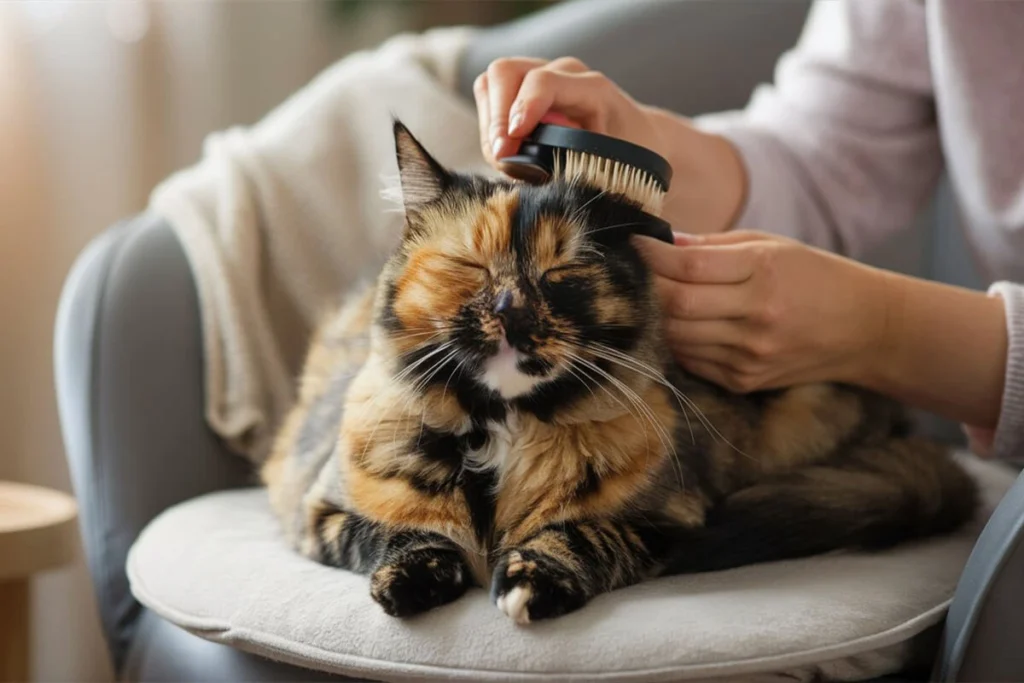
The genetic combination responsible for this striking coat occurs almost exclusively in female cats. The mix of black and orange results from the activation of different X chromosomes, creating the mosaic-like effect seen in tortoiseshell fur. Some torties also exhibit a “split face” pattern, where one side of the face looks darker while the other appears lighter.
Some tortoiseshell cats feature a dilute color variation, where their black and orange patches appear softer, resembling shades of gray, cream, or blue. These cats, known as dilute torties, inherit a recessive gene that lightens their fur while maintaining the tortoiseshell pattern. Whether bold or muted, a tortie’s coat remains a defining and captivating feature.
Grooming Tips for Cats
Keeping a tortoiseshell cat’s coat in top condition requires regular grooming, especially for long-haired varieties. Brushing removes loose fur, prevents matting, and reduces shedding. Short-haired torties benefit from a weekly brushing session, while long-haired torties, such as those with Persian or Maine Coon ancestry, need grooming at least two to three times per week.
Using a soft-bristle brush or a de-shedding comb helps remove dead hair and keeps the coat smooth and shiny. Regular brushing also minimizes hairballs by preventing excessive fur ingestion during self-grooming. A damp cloth or grooming mitt can help remove loose hairs while giving the tortie a relaxing massage.
Bathing a tortoiseshell cat isn’t usually necessary unless the cat gets into something sticky or dirty. Most cats groom themselves effectively, but if a bath becomes necessary, use a gentle, cat-safe shampoo and lukewarm water. Keep bathing sessions brief and stress-free to avoid making the cat anxious.
Trimming a tortie’s nails every two to three weeks prevents overgrowth and reduces the risk of scratching-related injuries. Providing scratching posts or cat trees helps maintain healthy claws and satisfies their natural scratching instincts. Regular ear cleaning and dental care complete a good grooming routine, keeping a tortie comfortable and healthy.
Cat Health and Wellness
Maintaining a tortoiseshell cat’s overall health requires a combination of proper nutrition, exercise, grooming, and regular veterinary care. A healthy tortie remains active, playful, and engaged with her environment. Providing mental stimulation through toys, puzzles, and interactive play sessions prevents boredom and destructive behavior.
Routine vet checkups help detect potential health issues early, ensuring a tortie stays in peak condition. Vaccinations protect against common feline diseases, while flea and parasite prevention keep the cat safe from external and internal infestations. Annual dental checkups reduce the risk of gum disease, which can lead to severe health complications if left untreated.
Weight management plays a crucial role in a tortie’s long-term well-being. Indoor cats face a higher risk of obesity due to limited activity, so owners should encourage daily exercise with interactive toys, climbing structures, and engaging play sessions. Keeping an eye on changes in appetite, litter box habits, or energy levels helps catch early signs of illness.
By staying proactive with health care, nutrition, and grooming, owners can ensure their tortoiseshell cats live long, happy, and healthy lives. A well-cared-for tortie rewards her owner with companionship, affection, and an endless display of her unique and bold personality.
Ensuring a Happy and Stimulating Environment
Tortoiseshell Cat Behavior
Tortoiseshell cats have a reputation for their bold, independent, and sometimes unpredictable behavior. Many cat owners use the term “tortitude” to describe their feisty and strong-willed nature. Unlike some cats that enjoy constant cuddling, torties often demand attention on their own terms. They may snuggle up one moment and swat at a hand the next, keeping their owners on their toes.
These cats form strong bonds with their favorite people but often act selectively affectionate. Some torties follow their humans from room to room, engaging in loud, expressive conversations with trills, chirps, and meows. Others prefer to observe from a distance and only seek attention when they feel like it.
Since torties have playful and energetic personalities, they need plenty of mental and physical stimulation. They enjoy chasing toys, climbing cat trees, and pouncing on anything that moves. If left without enough entertainment, they may create their own fun by knocking things over, chewing on cords, or opening cabinets. Keeping a tortie engaged with interactive toys, puzzle feeders, and scratching posts helps prevent destructive behavior.
Torties can also show a possessive streak, especially when it comes to their favorite toys, sleeping spots, or even their owners. Some may act territorial and swat at other pets who invade their space. Early socialization and training help them develop balanced behavior and prevent excessive aggression.
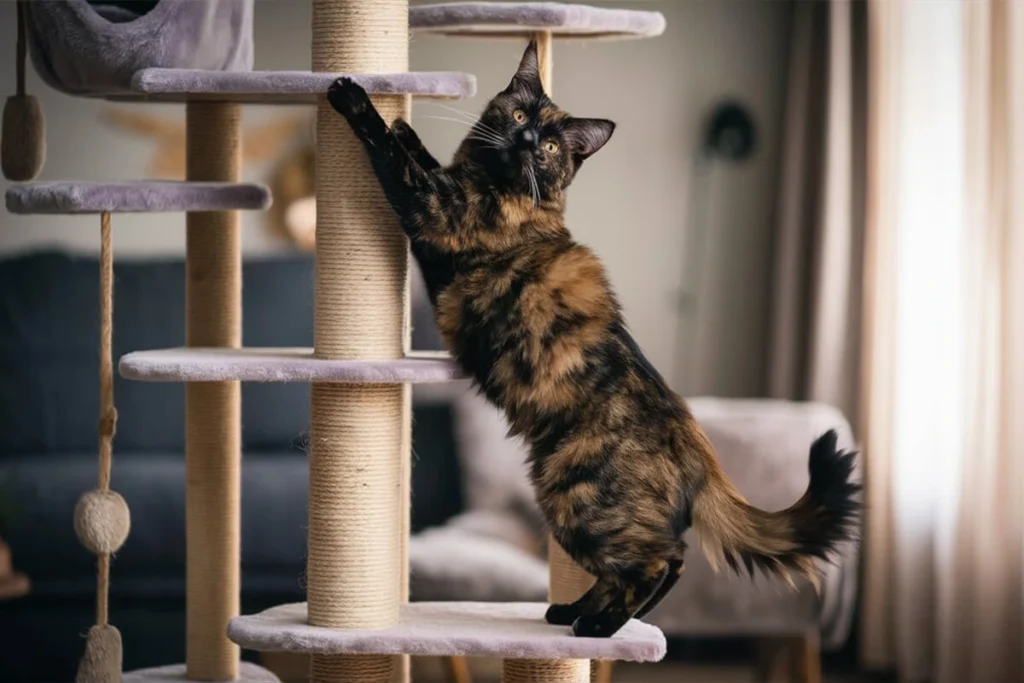
Cat Training Techniques
Training a tortoiseshell cat requires patience, consistency, and positive reinforcement. Unlike dogs, cats respond best to rewards-based training rather than punishment. Torties, with their independent and sometimes stubborn nature, may take longer to learn commands, but with persistence, they can pick up good behaviors.
Start with basic training by reinforcing positive actions with treats or praise. If a tortie scratches furniture, redirect her to a scratching post and reward her when she uses it. Clicker training works well for torties because it creates a clear association between an action and a reward.
Litter training usually comes naturally, but if a tortie starts eliminating outside the litter box, checking for medical issues or stress triggers helps resolve the problem. Keeping the litter box clean, using a low-dust litter, and providing multiple boxes in a multi-cat household encourages good bathroom habits.
Teaching tricks, such as “sit,” “high-five,” or “come,” can also be fun and engaging. Use small, tasty treats as motivation and practice short training sessions to keep the tortie interested. Since torties can have a mischievous streak, they may try to test boundaries. Staying patient and reinforcing good behavior consistently helps shape a well-mannered cat.
Feline Behavioral Traits
Tortoiseshell cats share many behavioral traits with other cats, but their personalities often feel larger than life. They express themselves vividly, using body language, vocalizations, and playful antics to communicate their feelings. A flicking tail, flattened ears, or dilated pupils often indicate excitement or agitation, while slow blinks and purring signal contentment.
These cats tend to be highly intelligent and curious, always exploring their surroundings and testing new experiences. Their problem-solving skills make them excellent at figuring out how to open cabinets, squeeze into tight spaces, or retrieve hidden toys. Owners should provide engaging activities to keep their minds stimulated, such as food puzzles and treat-dispensing toys.
Socialization plays a key role in shaping a tortie’s personality. Kittens that experience gentle handling and positive interactions from an early age grow into well-adjusted adults. While some torties remain wary of strangers, others confidently greet guests and demand attention.
Understanding a tortie’s behavioral traits helps owners create a nurturing and stimulating environment. These cats thrive in homes that respect their independence while also providing love, engagement, and plenty of opportunities to showcase their lively and affectionate personalities.
Monitoring Health and Veterinary Care
Common Health Issues in Cats
Tortoiseshell cats, like all felines, face certain health risks that owners need to monitor. Regular veterinary checkups, a balanced diet, and proper care help prevent many common illnesses. Understanding these health concerns allows owners to recognize early warning signs and seek treatment before conditions worsen.
1. Obesity and Weight-Related Problems
Indoor cats, including torties, often face a higher risk of obesity due to a lack of physical activity. Overfeeding and free-feeding contribute to excessive weight gain, which leads to joint problems, diabetes, and heart disease. Monitoring portion sizes, feeding high-quality protein-rich food, and encouraging daily exercise help prevent obesity-related health issues.
2. Urinary Tract Infections (UTIs) and Kidney Disease
Tortoiseshell cats, like many felines, can develop urinary tract infections or kidney problems, especially if they don’t drink enough water. Symptoms of a UTI include frequent urination, blood in the urine, or straining in the litter box. Kidney disease often progresses silently, so regular veterinary checkups and a moisture-rich diet with wet food help reduce the risk. Providing a cat water fountain encourages proper hydration and supports kidney health.
3. Dental Disease
Many cats suffer from dental problems like gingivitis, tooth decay, and gum infections. If a tortie shows signs of bad breath, drooling, or difficulty eating, dental disease may be the cause. Regular brushing with cat-safe toothpaste, offering dental treats, and scheduling professional cleanings help maintain a healthy mouth and prevent severe dental issues.
4. Feline Lower Urinary Tract Disease (FLUTD)
FLUTD affects cats of all ages and can cause painful urination, bladder inflammation, and urinary blockages, which can be life-threatening. Stress, obesity, and dehydration increase the risk of FLUTD. Feeding a diet rich in moisture, maintaining a clean litter box, and reducing stress through environmental enrichment help prevent this condition.
5. Mammary Tumors and Reproductive Health Issues
Since most tortoiseshell cats are female, they face a higher risk of developing mammary tumors, which often become cancerous. Spaying a cat before her first heat cycle significantly reduces this risk. Spayed cats also avoid uterine infections (pyometra) and unwanted pregnancies, leading to a longer and healthier life.
By recognizing these common health issues early and taking preventive measures, owners can ensure their tortoiseshell cats stay healthy and happy for years.
Cat Health and Wellness
Caring for a tortoiseshell cat’s health requires a combination of proper nutrition, regular veterinary visits, grooming, and mental stimulation. A well-balanced lifestyle helps prevent illnesses and promotes longevity.
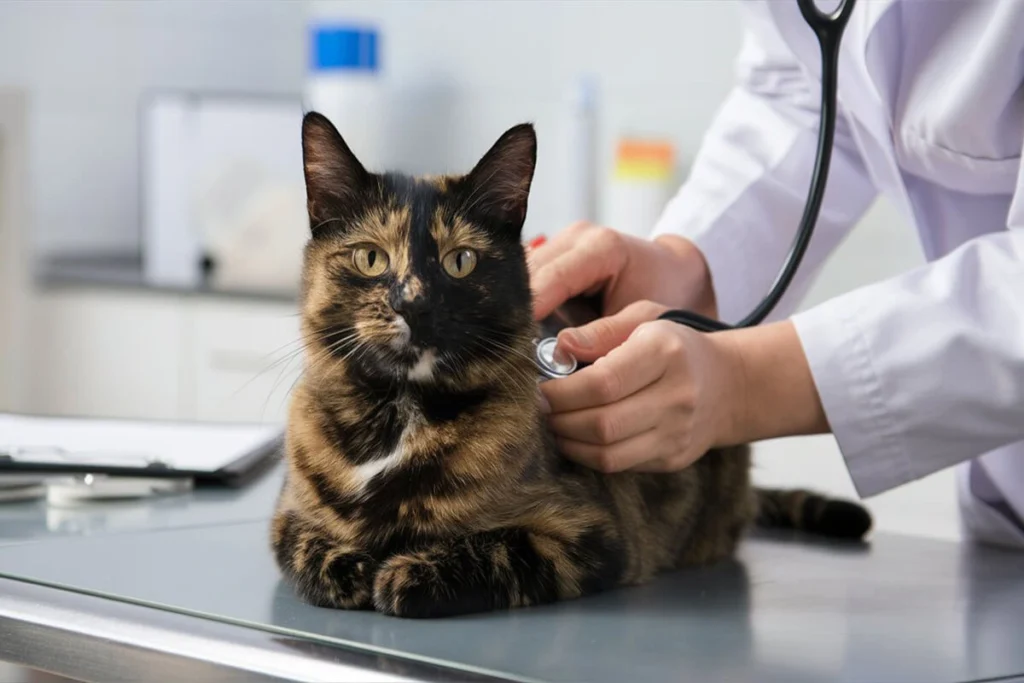
1. Routine Vet Visits
Scheduling annual or biannual vet checkups allows early detection of health problems. Vets monitor weight, dental health, and organ function while administering necessary vaccinations. Senior cats may require more frequent visits to manage age-related conditions.
2. Balanced Nutrition
Feeding high-quality cat food rich in animal protein supports muscle development, energy levels, and overall health. Omega-3 and Omega-6 fatty acids keep a tortie’s coat shiny and reduce inflammation. Avoiding excessive carbohydrates prevents obesity and digestive issues.
3. Hydration and Kidney Support
Tortoiseshell cats, like all felines, need proper hydration to maintain kidney and urinary health. Wet food provides moisture, while a cat water fountain encourages drinking. Placing multiple water bowls around the house ensures easy access.
4. Grooming and Hygiene
Brushing a tortie’s coat at least once a week removes loose fur, reduces shedding, and prevents hairballs. Long-haired torties need more frequent grooming to avoid matting. Keeping nails trimmed, ears clean, and litter boxes fresh contributes to overall well-being.
5. Exercise and Mental Stimulation
Daily playtime prevents obesity, strengthens muscles, and keeps a tortie engaged. Interactive toys, climbing trees, and puzzle feeders stimulate their natural hunting instincts and reduce boredom. Engaging in regular play sessions strengthens the bond between cats and their owners.
By following these wellness guidelines, owners can provide a fulfilling and healthy life for their tortoiseshell cats, ensuring they thrive both physically and mentally.
Training a Tortoiseshell Cat
Training a tortoiseshell cat requires patience, consistency, and a deep understanding of their independent nature. Unlike dogs, cats respond best to positive reinforcement rather than punishment. Torties, known for their strong personalities, may take longer to train, but with the right approach, they can learn commands, proper behavior, and even fun tricks.
1. Litter Box Training
Most kittens instinctively use a litter box, but some may need guidance. Placing them in the box after meals or naps helps reinforce the habit. Keeping the litter box clean, using unscented litter, and providing multiple boxes in a multi-cat household encourage good bathroom behavior. If a tortie suddenly stops using the litter box, checking for medical or stress-related issues helps address the problem.
2. Scratching Behavior
Torties love scratching, which helps them stretch, mark territory, and keep their claws healthy. Providing scratching posts, cat trees, or cardboard scratchers prevents damage to furniture. If a tortie scratches inappropriately, redirecting her to the correct surface and rewarding her reinforces good habits.
3. Teaching Basic Commands
Training a tortoiseshell cat to respond to commands like “sit,” “stay,” or “come” strengthens the bond between cat and owner. Clicker training, which involves using a clicking sound followed by a treat, helps reinforce positive behavior. Short, fun training sessions work best since torties may lose interest quickly.
4. Managing Aggression and “Tortitude”
Some torties show aggressive behavior when overstimulated or frustrated. Recognizing body language, such as flattened ears or flicking tails, helps owners avoid triggering defensive reactions. Encouraging gentle play, avoiding rough handling, and using toys to channel their energy reduces aggressive tendencies.
5. Socialization and Handling
Early socialization shapes a tortie’s personality and comfort level with people and other pets. Handling kittens frequently and introducing them to different environments, sounds, and people help them grow into confident adults. For older cats, gradual exposure and positive reinforcement create a more trusting relationship.
By using patience, consistency, and reward-based techniques, owners can train their tortoiseshell cats to develop good behaviors while respecting their unique and independent personalities.
Conclusion
Caring for a tortoiseshell cat requires patience, understanding, and a commitment to meeting her unique needs. These cats, known for their fiery personalities and striking coat patterns, bring endless charm and excitement into their owners’ lives. Whether they demand attention, show their playful side, or exhibit their independent streak, torties never fail to make a lasting impression.
Providing a balanced diet, regular grooming, and proper veterinary care ensures that a tortoiseshell cat remains healthy and happy. Since many torties develop strong opinions about their food, toys, and living space, owners must learn to respect their boundaries while reinforcing positive behaviors. Consistency in training helps curb stubborn tendencies, and plenty of mental and physical stimulation prevents boredom and destructive habits.
Understanding a tortie’s behavioral quirks and communication style allows owners to build a deep and trusting bond. Some tortoiseshell cats crave attention and follow their humans everywhere, while others enjoy quiet observation from a cozy spot. Their unique “tortitude” makes them endlessly entertaining, but it also requires patience and adaptability.
By creating a safe, engaging, and loving environment, tortoiseshell cat owners can ensure their feline companions live long, fulfilling lives. In return, these captivating cats offer companionship, affection, and a daily dose of unpredictable charm. No two torties are alike, but one thing remains certain—life with a tortoiseshell cat is never boring!
Read More About Cats and other breeds Over Here!
You Can Find Amazing stuff for your Furry Friend on Pet MD Official
